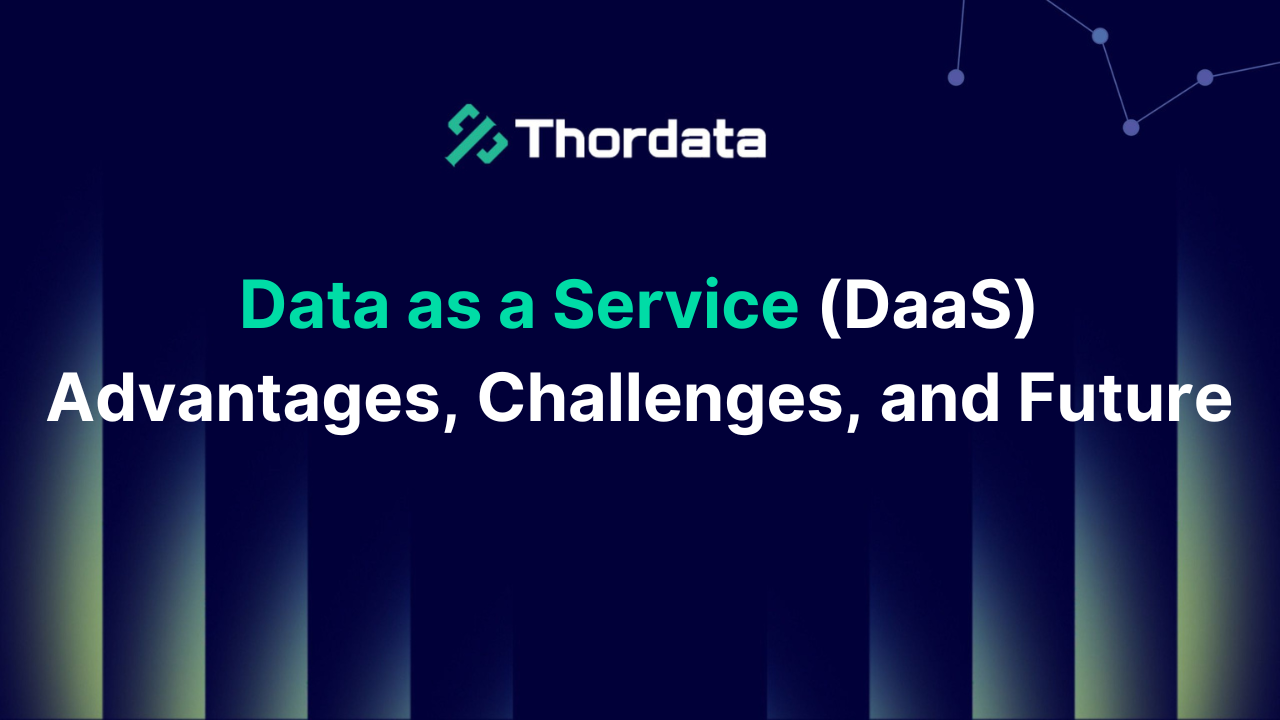Data as a Service (DaaS): Advantages, Challenges, and Future


In today’s digital age, data has become the core driving force behind business decision-making. However, the challenges of handling and managing massive amounts of data have put immense pressure on many companies. Especially small and medium-sized businesses that lack resources.
DaaS provides businesses with solutions for achieving real-time data access, scaling operations on demand, and reducing data costs. So, what exactly is DaaS, and what benefits can it bring to businesses? This article will answer these questions.
What is Data as a Service?
Data as a Service (DaaS) is a cloud-based service model that allows users to access, process, and analyze data on demand over the internet. Without the need to manage and maintain local hardware and software infrastructure. Simply put, DaaS delivers data through a cloud platform, enabling users to query, analyze, and use it anytime, anywhere.
What are the Advantages of Data as a Service?
Data as a Service (DaaS) provides many significant benefits for businesses and organizations. Primarily in cost reduction, increased efficiency, enhanced flexibility, and decision support. Here are several key benefits of DaaS:
1. Cost Reduction
Traditional data storage and management typically require businesses to purchase expensive hardware and hire specialized IT teams to maintain these systems. With DaaS, businesses don’t need to buy hardware and software themselves. All infrastructure is managed by the cloud service provider. DaaS services help business save maintenance costs.
2. Improved Data Access and Sharing Efficiency
DaaS allows employees to access real-time data from anywhere, as long as they have an internet connection. This efficient data access can significantly improve work efficiency and decision-making speed.
Data can be centrally stored and shared via a cloud platform. Which enabs multiple departments and teams to collaborate on the same data source . Without frequent file transfers and version control, reducing communication and collaboration barriers.
Traditional data storage methods may lead to data silos. Where different departments or business units cannot share data. With DaaS, businesses can break down these silos and achieve data flow and sharing across departments.
3. Flexibility and Scalability
DaaS allows businesses to increase storage space or computing power as needed, without having to worry about hardware and resource management. This scalability enables businesses to quickly adapt to market changes. This is especially important for small and medium-sized enterprises as they can scale resources based on demand.
4. Enhanced Data Security
Many DaaS providers adhere to industry standards and regulatory requirements such as GDPR (General Data Protection Regulation) or HIPAA (Health Insurance Portability and Accountability Act). They help businesses comply with legal regulations.
Challenges of Data as a Service
Despite its benefits, DaaS faces several potential risks and challenges in practical application. Here are some detailed insights:
Data Risks
Due to technical vulnerabilities, hacking, or internal staff misconduct, sensitive data may be illegally obtained and exposed. Which leads to severe losses for businesses and individuals. For instance, the leakage of customer information could result in fraud.
Data Accuracy and Integrity
The diversity and complexity of data sources may lead to inconsistent data quality, including errors, missing data, or duplicates. Which affects the reliability of data analysis and decision-making.
Compliance Risks
Different countries and regions have varying data protection laws and regulations. Which may cause compliance issues during cross-border data transmission and service provision. This can expose businesses to legal risks and hefty fines.
Some industries, such as finance and healthcare, have strict regulatory requirements on data usage. DaaS providers must ensure compliance with industry standards and regulations.
Technical Challenges
Enterprises often have diverse internal and external data sources with different formats. DaaS must overcomes the challenges of integrating and fusing data. To ensure effective combanation and sharing.
To ensure data security and privacy. DaaS providers must continuously update and improve security technologies.
What Are the Different Types of Data as a Service?
Data Storage Services
Modern cloud platforms enable businesses and individuals to store data without owning or managing physical hardware. Examples include AWS S3 and Google Cloud Storage.
Data Analysis Services
These services facilitate data collection, processing, analysis, and visualization. By utilizing these tools, companies can manage and analyze data efficiently. Without investing in complex internal infrastructures.
Data Security Services
Prioritizing the protection of digital assets, these services provide encryption, access control, authentication, and security auditing. To ensure the confidentiality, integrity, and availability of information.
Data Integration Services
These services eliminate silos, enhance data consistency, and foster better collaboration and decision-making.
Data as a Service Use Case Scenarios
1.DaaS enables businesses to analyze user profiles
DaaS platforms combine data on user behavior, purchasing history, product recommendation systems, and third-party social media insights. This integration empowers e-commerce platforms to deliver tailored product recommendations for individual users.
2.DaaS facilitates precise inventory management Leveraging
The DaaS platform allows businesses to access real-time supply chain data, such as supplier inventory, transportation updates, and demand forecasts. This combaned information helps in visualizing the supply chain, enabling more accurate planning and informed purchasing decisions.
3.DaaS helps businesses refine market positioning and analyze competitors effectively.
Through efficient collection, integration, and evaluation of market trends and competitor activities, businesses can refine their market positioning strategies. This process also improves the understanding of competitors’ approaches while enhancing the speed and precision of strategic decision-making.
How to Integrate DaaS with Your Existing Business Activities?
The 2024 Gartner report predicts a 19.1% growth in global public cloud services, including DaaS. Which shows more adoption and investment in cloud technologies. Businesses are primarily driving this growth because the rising demand for data management solutions.
Using DaaS to enhance your business activities is an inevitable trend. How to integrate DaaS into your business operations? Consider the following points:
1.Define Business Needs and Goals
Conduct an in-depth review of current business processes to gain clarity on operations and pinpoint areas where data-driven support can add value.
2.Select an Appropriate DaaS Provider and Service
Assess potential providers based on their technical expertise, data quality standards, security protocols, service reliability, and relevant industry experience. Opt for a well-regarded provider with a proven track record.
3.Facilitate Data Integration and Unification
Collaborate with the chosen DaaS provider to build secure, dependable data connections and interfaces, ensuring seamless data flow between your internal systems and the DaaS platform.
4.Provide Training and Support
Educate employees on DaaS fundamentals to enhance data literacy and develop their skills in applying data insights effectively.
5.Pursue Continuous Optimization and Innovation
Regularly monitor the integration process to assess its effectiveness, making necessary tweaks and leveraging innovative strategies to drive improvements over time.
The Future of Data as a Service
As organizations face increasing data demands, DaaS will continue to evolve, offering more advanced, flexible, and intelligent solutions. Emerging trends indicate deeper integration of artificial intelligence and machine learning, improved data security and privacy protections, and further integration of diverse data formats.
Conclusion
DaaS is solidifying its role as a key enabler of digital transformation. By leveraging the cloud, businesses can enhance data management, reduce costs, and improve decision-making, all while adapting quickly to market changes.
Frequently asked questions
Why should you use Data as a Service (DaaS)?
Leveraging Data as a Service (DaaS) provides numerous benefits for businesses. It minimizes the requirement for extensive data storage infrastructure and hardware, resulting in lower expenses for technology upkeep and labor. Additionally, it offers scalable solutions, enabling organizations to adjust their storage and computing resources in line with evolving demands.
What is SaaS vs DaaS?
SaaS, or Software as a Service, is a service model that delivers software applications via the internet.DaaS, or Data as a Service, is a cloud-based model that lets users access, manage, and analyze data as needed, without the need to maintain their own storage and processing systems. It provides access to various types of data through a cloud platform, helping decision-making and supporting business processes.
What is meant by data as a service platform?
A DaaS platform is a cloud-based tool that helps companies store, process, and analyze data. It allows companies to access data anytime, making work easier. These platforms come with tools to help clean, integrate, and protect data. By using DaaS, businesses can directly use data from the cloud without needing to build complex systems themselves.
Where is DaaS used?
DaaS platforms find applications in a wide range of industries, such as retail and e-commerce, financial services, healthcare, logistics and supply chain management, manufacturing, as well as advertising and marketing. They improve data management efficiency and enable businesses to make more informed decisions.
About the author
Clara is a passionate content manager with a strong interest and enthusiasm for information technology and the internet industry. She approaches her work with optimism and positivity, excelling at transforming complex technical concepts into clear, engaging, and accessible articles that help more people understand how technology is shaping the world.
The thordata Blog offers all its content in its original form and solely for informational intent. We do not offer any guarantees regarding the information found on the thordata Blog or any external sites that it may direct you to. It is essential that you seek legal counsel and thoroughly examine the specific terms of service of any website before engaging in any scraping endeavors, or obtain a scraping permit if required.